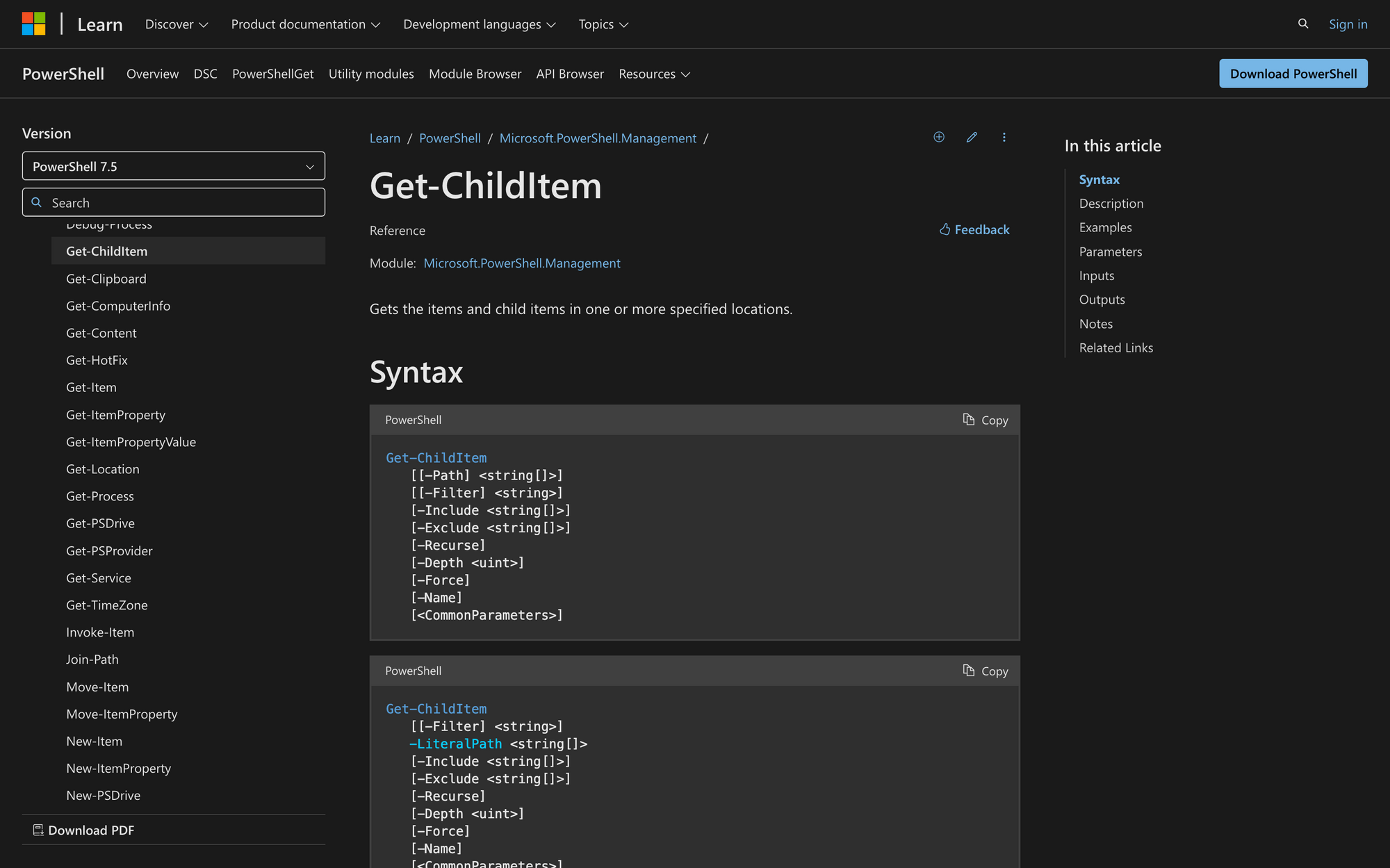How to Use Get-ChildItem in Powershell

The Get-ChildItem cmdlet is one of the most frequently used commands in PowerShell. It allows users to retrieve the contents of a folder, registry hive, or certificate store, making it essential for file system navigation and automation tasks.
Whether you're listing files in a directory, filtering for specific attributes, or working with registry keys, understanding how this cmdlet works is foundational for any PowerShell user.
What is the Get-ChildItem Cmdlet?
The Get-ChildItem cmdlet retrieves the child items - such as files and subdirectories - within a specified container. It works across multiple providers, including the file system, registry, and certificate store.
This cmdlet is often used to list files in a directory, recursively search for items, or filter results based on attributes like hidden, read-only, or system files.
Key Parameters of the Get-ChildItem Cmdlet
Below is an overview of key parameters used with the Get-ChildItem cmdlet. These parameters control what is listed, how deep the listing goes, and how outputs are filtered or formatted.
Each of these parameters is context-sensitive. For example, -File and -Directory only apply to the FileSystem provider. Other providers, such as Registry or Certificate, support a different set of parameters, which may include -CodeSigningCert, or dynamic parameters available only at runtime.
Using combinations of these parameters allows you to tailor the output precisely - for instance, listing all non-hidden items recursively from a target location up to a certain depth:
Get-ChildItem -Path "C:Project" -Recurse -Depth 2 -File -Attributes !Hidden
This command gets all non-hidden files up to two levels deep from the directory "C:Project".
Key Differences: Get ChildItem vs Get-Item
3 Practical Use Cases for the Get-ChildItem Cmdlet in PowerShell
Here are three common scenarios where Get-ChildItem proves especially useful:
1. Listing All Files in a Directory Tree
System administrators often need a quick way to audit all files under a given path, including subfolders. By combining Get-ChildItem with the -Recurse flag, they can retrieve a complete list of all files in a directory tree:
Get-ChildItem -Path "C:UsersJohnDoeDocuments" -Recurse
This helps when preparing for backups, scanning file types, or identifying large folders.
2. Filtering Specific File Types or Attributes
When working with logs, scripts, or other targeted file types, the -Filter or -Include parameters help limit output to relevant items. For example, to find all .log files in a folder:
Get-ChildItem -Path "C:Logs" -Filter *.log
This is especially helpful for troubleshooting, cleaning up old files, or reviewing application outputs.
3. Auditing Hidden or System Files
To identify hidden or system-protected files, administrators can use the -Attributes parameter. For instance, to list all hidden files in a directory:
Get-ChildItem -Path "C:Temp" -Attributes Hidden
This is useful during security audits, forensic checks, or when verifying that system files are correctly placed and untouched.
Prerequisites
Before using Get-ChildItem, ensure the following requirements are met:
PowerShell Version: The cmdlet works in Windows PowerShell 5.1 and in PowerShell 7.1 and above, including PowerShell Core on cross-platform systems.
Module Availability: Get-ChildItem is included in the Microsoft.PowerShell.Management module, which is loaded by default in most environments.
Permissions: You must have the necessary access rights for the resource you're querying. For example, reading from a secured directory, registry hive, or certificate store requires appropriate permissions.
Supported Providers: The behavior of Get-ChildItem changes depending on the provider (e.g., FileSystem, Registry, Certificate, Environment). Some parameters and outputs vary across providers.
Check Providers: Use the Get-PSProvider cmdlet to view available providers on your system and confirm compatibility with your target path:
How to Use Get-ChildItem in Powershell: 6 Examples
1. List Files in the Current Directory
If no -Path is specified, Get-ChildItem defaults to the current working directory. This command lists all non-hidden files and folders in that location. It’s the simplest way to inspect what's in your present directory.
Get-ChildItem
2. List Files with Specific Extension
Use the -Filter parameter to return only files matching a certain pattern - in this case, files ending in .txt. It’s more efficient than using Where-Object because filtering happens at the provider level.
Get-ChildItem -Path "C:Users" -Filter "*.txt"
3. Use Wildcard Characters for Flexible Matching
This matches any .log file that contains “2023” in the filename. You can use * to match zero or more characters and ? to match a single character. Useful for retrieving files with partial or uncertain names.
Get-ChildItem -Path "C:Logs*2023*.log"
4. Get a List of Directories Only
Adding the -Directory switch limits the output to only folders, excluding files. This is ideal when you need to process or loop through folders only (e.g., for backups or batch operations).
Get-ChildItem -Path "C:Projects" -Directory
The -Directory parameter filters the output to show only folder names.
5. Include Hidden Items and System Files
By default, hidden files and system items are excluded. Use -Force to include them in the results - especially useful when working in protected directories like C:\Windows where many items are hidden by design.
Get-ChildItem -Path "C:Windows" -Force
The -Force parameter displays hidden items and system files not shown by default.
6. Use Complex Combinations of Attributes
This command returns all files in C:\Reports and its subdirectories (-Recurse) that are not read-only (!ReadOnly) and are marked as archive (Archive). It’s helpful when managing files based on specific file system attributes - common in automated cleanup or backup tasks.
Get-ChildItem -Path "C:Reports" -Attributes !ReadOnly,Archive -Recurse
The Get-ChildItem cmdlet is a versatile and essential command for listing and filtering items within containers in PowerShell. Whether working with directories, registry nodes, or certificates, knowing how to use its parameters like -Path, -Recurse, -Filter, and -Attributes makes it easier to generate precise outputs.
Mastering its use helps in tasks ranging from file system cleanup to registry analysis and automation.

